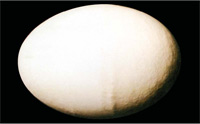
Body-checked eggs

Description
The shells of body-checked eggs are marked by grooves and ridges called ‘checks’. These are usually at the ends of the egg, especially the pointed end.
Checks at the middle, or ‘waist’, often completely encircle the egg. Such defects are the result of repairs to damage caused by stress or pressure when the egg is in the shell gland. This stage of development usually occurs in the last hours of the light period or the first half of the dark period.
Incidence
The percentage of body-checked eggs increases with flock age: at 35 weeks it can be up to 1%; at 60 weeks it can be 9%.
| Cause | Control |
|---|---|
| Ageing of bird | Keep flock age as low as economically possible. |
| Keep flock age as low as economically possible. | Minimise human activity in and around the layer shed, particularly during the critical period of the last few hours of the light period and the first half of the dark period. Increase shed security to stop other birds and animals entering the shed. |
| Incorrect lighting programme | Avoid using lighting programmes that keep birds active during the critical period. Where possible, light periods should not be longer than 15 hours. Do not use lighting programmes which allow for a ‘midnight snack’. |
| Crowding | Avoid overstocking, particularly as birds become older. |
| Disease | Make sure that layer stock come from parent stock vaccinated against infectious bursal disease. |
COPYRIGHT NOTICE: OPTIMUM EGG QUALITY - A PRACTICAL APPROACH
© The State of Queensland, Australia (through its Department of Primary Industries and Fisheries) and DSM Nutritional Products Ltd., 2007. No part of this publication may be reproduced, copied or transmitted save with prior written permission of Director, Intellectual Property Commercialisation Unit, Department of Primary Industries and Fisheries, GPO Box 46 Brisbane, Queensland, Australia 4001, and DSM Nutritional Products Ltd.
© The State of Queensland, Australia (through its Department of Primary Industries and Fisheries) and DSM Nutritional Products Ltd., 2007. No part of this publication may be reproduced, copied or transmitted save with prior written permission of Director, Intellectual Property Commercialisation Unit, Department of Primary Industries and Fisheries, GPO Box 46 Brisbane, Queensland, Australia 4001, and DSM Nutritional Products Ltd.






